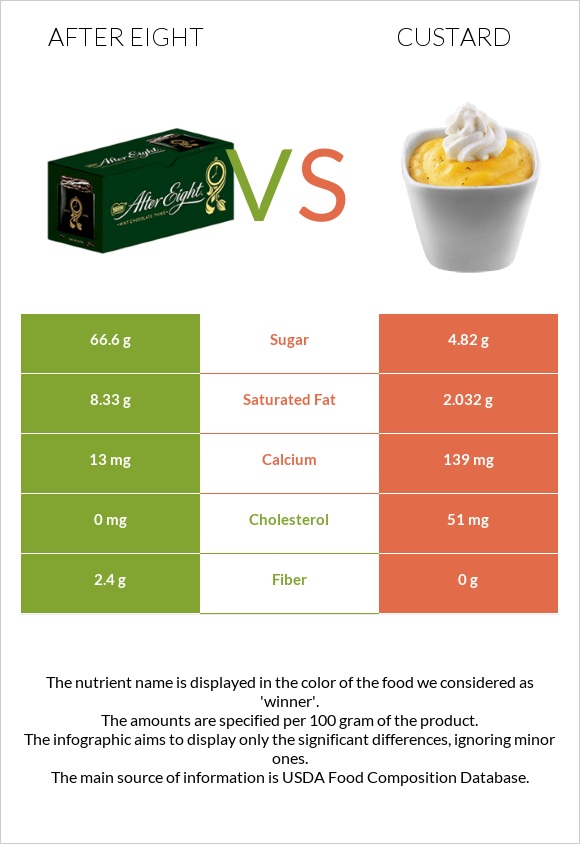After eight vs. Custard — In-Depth Nutrition Comparison
Compare
Summary of differences between after eight and custard
- After eight has more fiber, while custard has more calcium.
- After eight covers your daily need for saturated fat, 31% more than custard.
- The amount of sugar in custard is lower.
These are the specific foods used in this comparison Candies, NESTLE, AFTER EIGHT Mints and Egg custards, dry mix, prepared with whole milk.
Infographic

Infographic link
Mineral Comparison
Mineral comparison score is based on the number of minerals by which one or the other food is richer. The "coverage" charts below show how much of the daily needs can be covered by 300 grams of the food.
| Contains more IronIron | +67.6% |
| Contains less SodiumSodium | -98.8% |
| Contains more CalciumCalcium | +969.2% |
Vitamin Comparison
Vitamin comparison score is based on the number of vitamins by which one or the other food is richer. The "coverage" charts below show how much of the daily needs can be covered by 300 grams of the food.
| Contains more Vitamin CVitamin C | +∞% |
| Contains more Vitamin AVitamin A | +∞% |
All nutrients comparison - raw data values
| Nutrient |  |
 |
DV% diff. |
| Saturated fat | 8.33g | 2.032g | 29% |
| Vitamin B12 | 0.52µg | 22% | |
| Carbs | 79.53g | 17.6g | 21% |
| Phosphorus | 130mg | 19% | |
| Cholesterol | 0mg | 51mg | 17% |
| Vitamin B2 | 0.22mg | 17% | |
| Calories | 432kcal | 122kcal | 16% |
| Vitamin B5 | 0.699mg | 14% | |
| Calcium | 13mg | 139mg | 13% |
| Fats | 11.9g | 4g | 12% |
| Selenium | 6µg | 11% | |
| Fiber | 2.4g | 0g | 10% |
| Vitamin D | 47 IU | 6% | |
| Potassium | 207mg | 6% | |
| Vitamin A | 0µg | 52µg | 6% |
| Vitamin D | 1.2µg | 6% | |
| Protein | 1.67g | 3.99g | 5% |
| Zinc | 0.51mg | 5% | |
| Vitamin B1 | 0.061mg | 5% | |
| Vitamin B6 | 0.064mg | 5% | |
| Magnesium | 16mg | 4% | |
| Sodium | 1mg | 84mg | 4% |
| Iron | 0.57mg | 0.34mg | 3% |
| Copper | 0.03mg | 3% | |
| Monounsaturated fat | 1.127g | 3% | |
| Folate | 9µg | 2% | |
| Choline | 11.8mg | 2% | |
| Polyunsaturated fat | 0.312g | 2% | |
| Vitamin B3 | 0.132mg | 1% | |
| Vitamin C | 0mg | 0.1mg | 0% |
| Net carbs | 77.13g | 17.6g | N/A |
| Sugar | 66.6g | 4.82g | N/A |
| Vitamin E | 0.06mg | 0% | |
| Manganese | 0.007mg | 0% | |
| Vitamin K | 0.2µg | 0% | |
| Tryptophan | 0.082mg | 0% | |
| Threonine | 0.192mg | 0% | |
| Isoleucine | 0.207mg | 0% | |
| Leucine | 0.337mg | 0% | |
| Lysine | 0.214mg | 0% | |
| Methionine | 0.091mg | 0% | |
| Phenylalanine | 0.173mg | 0% | |
| Valine | 0.233mg | 0% | |
| Histidine | 0.092mg | 0% | |
| Omega-3 - DHA | 0.003g | N/A |
Macronutrient Comparison
Macronutrient breakdown side-by-side comparison
Protein:
1.67 g
Fats:
11.9 g
Carbs:
79.53 g
Water:
6.3 g
Other:
0.6 g
Protein:
3.99 g
Fats:
4 g
Carbs:
17.6 g
Water:
73.45 g
Other:
0.96 g
| Contains more FatsFats | +197.5% |
| Contains more CarbsCarbs | +351.9% |
| Contains more ProteinProtein | +138.9% |
| Contains more WaterWater | +1065.9% |
| Contains more OtherOther | +60% |
Fat Type Comparison
Fat type breakdown side-by-side comparison
Saturated fat:
Sat. Fat
8.33 g
Monounsaturated fat:
Mono. Fat
0 g
Polyunsaturated fat:
Poly. Fat
0 g
Saturated fat:
Sat. Fat
2.032 g
Monounsaturated fat:
Mono. Fat
1.127 g
Polyunsaturated fat:
Poly. Fat
0.312 g
| Contains less Sat. FatSaturated fat | -75.6% |





